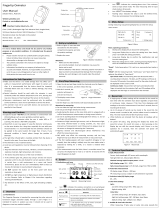
Warning
1.Warning,Do not modify this equipment without authorization of manufacturer.
2.Warning,Keep away from the wet medical equipment such as drip or other similar
liquid simulation as far as possible.
3.Warning, Check the sensor site every half an hour to ensure adequate blood
circulation, intact skin, and appropriate sensor location. Otherwise, it may cause skin
damage, compressive necrosis, or inaccurate measurement readings.
4.Warning,With the increasing number of radio devices or other noise sources from
electric equipment in health care departments , our product may be interrupted when
working because of their interference. The closer the distance between each other is
or stronger the signal is, the more serious the interference will be.
The electromagnetic interference sources in health care departments may include:
(1).Electronic surgical instruments communications equipment
(2).Mobile Phones
(3).Automotive two-way wireless communications equipment
(4).Electronic apparatus
(5).High-definition television
In this interference, the measurement values may deviate, or the device may not work.
When interfered, the product may produce abnormal phenomenon: unstable reading
values, outages or other functions of error.If such a case, the use of the site should be
checked to identify interference and the elimination of the following measures:
(1)Shut down the equipment in the vicinity and then re-open in order to identify
interference equipment;
(2)To change the direction or location of the interference equipment;
(3)To increase the distance between the product and interference sources.
5.Warning,Do not put the battery close to the fire or into the fire to avoid the battery
explosion. Do not use the battery when it leaks or molds.
6.Warning, Device conforms to the requirement of RoHS directive.
7.Warning, Device application component materials are certified for biological
compatibility.
8.Do not leave the oximeter unattended around children or infants. Small items such
as the battery door, battery,and lanyard may become choking hazards if swallowed.
Infants or children may be entangled in the lanyard, thus causing strangulation.
9.Do not stare at light (the infrared is invisible) which emitted from the
oximeter,which is harmful to the eyes.
10.Do not use the oximeter for purposes other than its intended use. Do not place the
oximeter on edema or fragile tissues.
11.Warning, Do not use the oximeter close to a permanent magnet.
12.Warning, Do not use the finger pulse oximeter in an MRI or CT environment.
13.Warning,Do not use the finger pulse oximeter during defibrillation and
electrosurgey.
14.Warning,Do not use the finger pulse oximeter in the presence of flammable
anesthetics or other flammable substances, oxygen-enriched environments, or nitrous






















